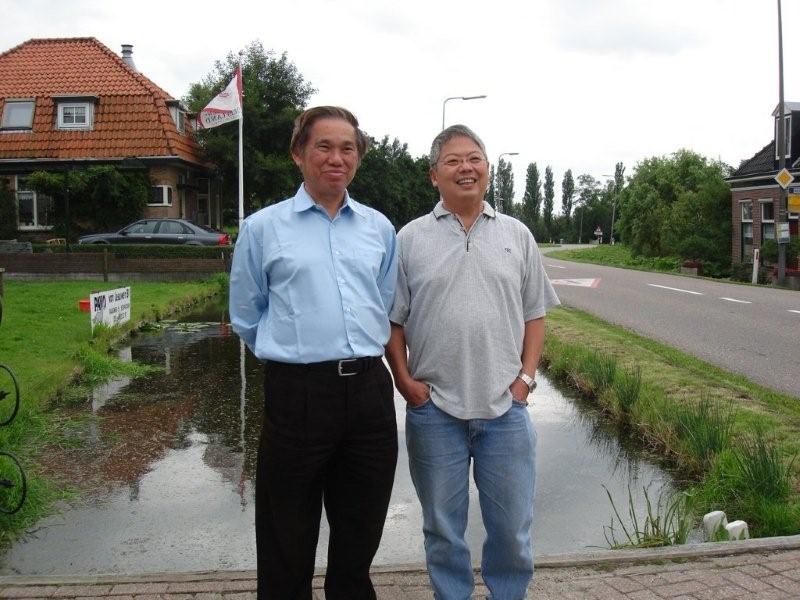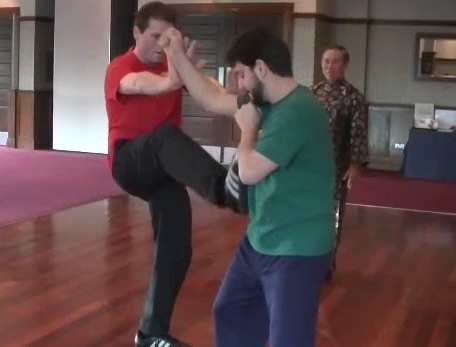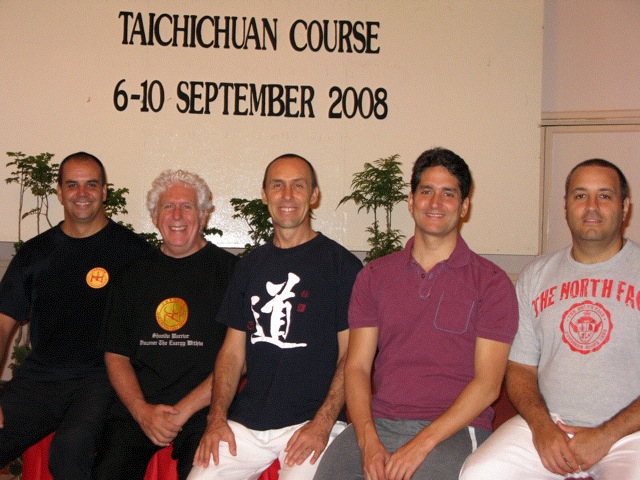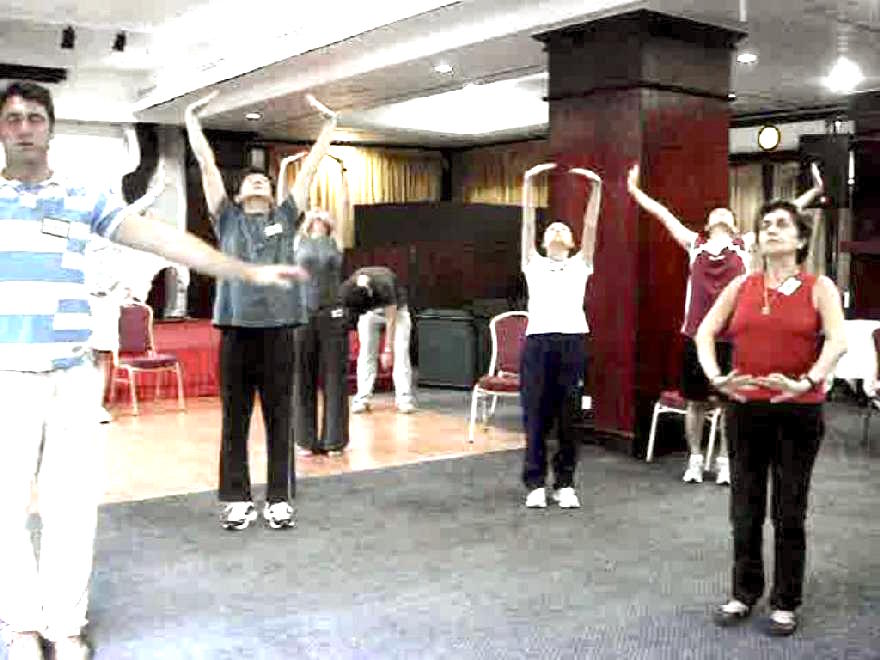SELECTION OF QUESTIONS AND ANSWERS
AUGUST 2010 PART 2

Practicing the Shaolin arts makes us happy, like Grandmaster Wong and his student, Dr Lie Kai Siang, enjoying their holidays in Holland
Question 1
Firstly I would like to give thanks to you and the Shaolin Wahnam Family for upholding and dissemination of genuine Shaolin Arts/Disciplines. It is an honor, privilege and pleasure to learn from you and your students, both directly and indirectly.
— Andrew, USA
Answer
Thank you for your kind words.
We in Shaolin Wahnam are very fortunate to have learnt these Shaolin arts which have given us a lot of beneifts. As these arts have been greatly debased today, we are concerned that they may be lost to posterity if we keep their secrets exclusively.
Many people, especially those practicing debased arts, may be angry at the above statement, and question what rights we have to claim that our arts are genuine and others debased. They have the rights not to believe us and to believe theirs are genuine. But it is a fact that we enjoy good health, have internal force, are able to use Shaolin and Taijiquan techniques for combat, and experience spiritual joys, whereas those whom we consider practice debased arts endure pain and internal injuries, do not believe in internal force, use Kick-Boxing or other martial styles for fighting, and are often angry and stressful.
We believe that genuine Shaolin arts (and genuine Taijiquan) give the types of benefits we enjoy. We also believe that those who practice Shaolin arts but are unhealthy, scoff at internal force, use Kick-Boxing instead of Shaolin techniques for fighting, and are often angry or stressful, have practiced debased arts. If these practitioners tell us that they use Kick-Boxing because Shaolin techniques cannot be used for fighting, or that internal force is a myth, we do not want to waste our time arguing with them.
On the other hand, there are many other students who are happy with their Shaolin practice although they have no internal force and are unable to use Shaolin techniques for combat. We do not tell them our arts are better or ask them to learn from us. We tell them to continue enjoying their practice and wish them well.
But those who wish to learn from us, and if they are deserving, we teach them generously, hoping that their practice will maintain the genuine Shaolin arts for posterity.
Question 2
I would like to ask if there is a specialized set in Shaolin Kung Fu which is similar to the techniques and philosophy of Kenpo Karate or American Kenpo.
Answer
Yes, there are many sets in Southern Shaolin Kungfu that are similar to Kenpo Karate or America Kempo. These kungfu sets, however, are not specialized sets; they are taught at the beginning of a student's career.
In fact many years ago when I read an excellent book by the Kenpo Karate grandmaster you mentioned, I was surprised that his style was quite similar to the Hoong Ka Kungfu I practiced, though it was not as elaborated.

Footwork is very important in both Shaolin Kungfu and Taijiquan
Question 3
I may be wrong in the philosophy, so anyone is free to correct me, but American Kenpo emphases defensive footwork with handwork when the opponent strikes, counter-attacking the first strike and a successive rapid-fire attack pattern to multiple vital points of the body to overwhelm the attacker with strikes. I don't know if this goes along with the Shaolin philosophy.
Answer
I am not well versed in American Kempo to comment on it. My comments apply to Shaolin Kungfu.
Yes, footwork is very important in both attack and defence, a fact that many Shaolin students are unaware of. There is a kungfu say as follows: "Fist strikes 30%, leg strikes 70%". Here the word "strike" is used generally to include any martial art movement; it does not just refer to striking. Hence, comparatively speaking, only 30% of an outcome of a combat is determined by hand movements, 70% by foot movements.
Apart from this, even at the elementary stage, Shaolin combat philosophy is more elaborated than what you have described. We do not always respond with successive rapid-fire counter-attacks. We may just defend and watch, defend then counter-attack, defend and counter-attack running together, or counter-attack without defending. Our students learn these skills, together with good footwork, progressively right at the start of their combat training in our Combat Sequences 1 to 4.
Why don't we use more advanced skills immediately instead of first learning how to defend then counter. It is because not only we can progress faster if we build our foundation first, but also there are occasions when these "lower" level skills are more appropriate or even necessary.
We do not just strikes, which are covered in our Combat Sequences 1 to 8. We also counter with kicks, felling techniques and chin-na, whcih are covered in our Combat Sequences 9 to 16.
All these skills and techniques form our basic training programme. Only when they are good at their basics, they progress to specialization.
Question 4
Also, if one is an expert or master of chi kung, is he able to sense the chi of others? By that I mean not just illness or stagnation of chi. Could he, or example, be able to tell that the flow of X's chi is greater than Y's chi? Is that a by-product of training chi or a skill that must be learned or specialized in?
Answer
Yes, these skills are common among instructors, and even among many of our students. They develop these skills as a result of their normal training; they do not need specialized methods to learn these skills.
For us who practice chi kung regularly, it is easy to tell not only whether a person is sick because of his chi stagnation but also whether a person's chi is stronger than that of another person. As an analogy, if you drive regularly, when a person takes on the wheel, it is easy to tell not only whether he can drive, but whether he is a good or bad driver.
We can also tell many other things about his combat ability, like whether he has internal force, what techniques he is likely to use, whether he is a rough straigh-forward fighter or a subtle, cunning opponent.
For those who are more advanced, we can tell these things not only from direct observation but even from what he writes. This in fact happens quite frequently in our discussion forum.
This sounds incredible to many people, but to the initiated it is actually obvious. Let us take a simple example. When a forum visitor says that chi is just another name for muscular strength, we know that he has no internal force. We also know that when he fights, he will tense his muscles and become tired easily.

It is easy for the initiated to tell a person's level of internal force from his appearance. It is obvious that these Taijiquan practitioners - Sifu Piti, Sifu Riccardo, Sifu Rama, Andrea and Sifu Antonio - are not only happy but very powerful.
Question 5
Is it also possible for a chi kung expert/master to have the ability to exorcise bad spirits/energies naturally or is that another learned skill? I know that part of the philosophy of your school is to help all beings so this may or may not be in league with your teachings.
Answer
Here is some good news for those who practice genuine high-level chi kung, A high-level chi kung practitioner will naturally repel bad spirits and bad energy. The flowing energy of a high-level practitioner is like electricity to low spirits. They will find if harmful to them to come near.
But exorcising bad spirits is another issue. It has to be learned, and is not a skill we practice.
Question 6
When practicing chi kung, can one undo the bad karma of one's ancestry? I know and believe what you teach about being human is a blessing, so a lot of good karma had to be present in order for one to be human. But if one knows that his ancestry had some bad karma and he does not want it to spill over to his offsprings, can chi kung help with that?
Answer
Yes, practicing high-level chi kung can undo the bad karma of one's ancestry, and help the practitioner not only to prevent previous bad karma from spilling over to his off-springs but instead pass on good karma to them.
Suppose the practitioner had hereditary asthma which he had inherited from his ancestors. By practicing chi kung diligently, he overcame his asthma. This is undoing bad karma in the physical dimension.
He was easily prone to anger. It was found out that his father and grandfather also exhibited this negative emotional trait. But by practicing chi kung, he became more tolerable and less easily angry. This is undoing bad karma in the emotional dimension.
He was not bright before practicing chi kung. His father and grandfather were not very clever either. But by practicing chi kung he found to his surprise that he could think more clearly. This is undoing bad karma in the mental dimension.
He discovered that his ancestors believed that bad luck ran through their family line due to a curse a wronged member placed on them. His ancestors seemed to miss every opportunity, and progress just missed them. But by practicing chi kung, his heart opened. He forgave all the wrongs done in the past, and he forgave himself. As his chi flow became vibrant he found that he was getting more and more lucky. This is undoing bad karma in the spiritual dimension.
How does practicing chi kung in the present erase bad karma of the past. It is because karma is fluid. Present karma is the result of past karma, and is the cause of future karma. Let us look at the example of our practitioner again.
The cause of his asthma did not happen the day before, or the year before. In fact, in his case, it happened long before he was born. His ancestors had asthma, and the gene that resulted in a physiological defect that caused asthma was with him at birth. In chi kung terms he was born with defective pre-natal chi.
But the wonderful thing about chi kung, which enables chi kung to overcome so-called incurable diseases, is that we do not have to worry about intermediate causes, because the fundamental cause of any disease is energy blockage. In the case of this particular practitioner, the intermediate cause was a defective gene. This defective gene cause energy blockage which in turn caused asthma.
In other practitioners who also had asthma, the intermediate cause might be different. For some it might be excessive grief, for others it might be physical injury. In other words, some had experienced excessive grief which caused energy blockage. Others had suffered from physical injury which also caused energy blockage. Their energy blockage led to asthma.
But it did not matter what the intermediate causes were, so long as the energy blockage was cleared, they would recover from asthma, The process of energy flow in clearing the blockage would be different in the different practitioners. In the first practitioner, energy would be working on his defective gene, in the other practitioners energy would be working on clearing negative emotion or repairing physical damage.
But how did the various practitioners know where to direct their chi to, to do its clearing work? The practitioners did not need to direct their chi; chi would know best where to flow to, if the practitioners had generated a powerful chi flow and allowed it to flow freely. In chi kung terms, this is "wu-wei" -- after the practitioners had performed "you-wei". Chi, or energy, flows from high-energy levels to low-energy levels, and low-energy levels are where the problems lie as there is insufficient chi to do its work.
Thus, when our first practitioner recovered from asthma, he had restored the defective genes he had inherited from his ancestors. But he also had defective genes that made him to become angry easily, unable to think clearly, and depressed him spiritually. In chi kung terms the bad pre-natal chi he inherited from his ancestors resulted in energy blockage that caused him to suffer emotionally, mentally and spiritually. But by practicing chi kung he can clear the energy blockage, irrespective of its immediate causes. In modern terms, he could rectify his defective genes. Hence, when he bears off-springs in future, he will pass on his good genes.

Practicing high-level chi kung, as shown above in the October 2009 Intensive Chi Kung Course in Penang, is an excellent way to ensure good health
Question 7
Can you tell me if So Hark Fu, master of Hark Fu Mon, defeated many challengers in combat during his life? Was he a fearsome fighter and one of the best in China?
— Sarah, UK
Answer
Yes, So Hark Fu defeated many challengers in combat. He was one of the best fighters of his time.
So Hark Fu, which means "So the Black Tiger", was not his real name, which I do not know. He was quite dark in complexion, and expert in the Tiger Style of Southern Shaolin. His style is now known as Hark Fu Moon, which literally means "Gate of the Black Tiger". It uses a lot of Tiger Claws and is similar to Hoong Ka Kungfu.
So Hark Fu was rated as one of the "Ten Tigers of Kwangtung". Kwantung, or Guangdong in Mandrin, is a large province of South China well known for kungfu fighting.
It may be of interest to point out that Wong Fei Hoong, another great fighter and patriarch of many Hoong Ka lineages today, was sometimes wrongly regarded as one of the Ten Kwangtung Tigers. Actually he was not, but his father, Wong Kai Ying, was.
This does not mean Wong Fei Hoong was a lesser fighter. In fact today Wong Fei Hoong is more well known than many of the Ten Tigers. He was one or two generations later than the Ten Tigers. For example, Tit Kiew Sam, the first of the Ten Tigers, was Wong Fei Hoong's sigung, i.e. teacher's teacher..
Question 8
I am 20 years old and I have had diabetes since I was a child. I've heard from some people that I might be able to cure myself, and I would be extremely happy if I could. I would greatly appreciate any help you can offer.
— Francis, England
Answer
I can help you, but the most important is that you must help yourself.
Yes, diabetes can be overcome, and I have helped many people overcome the disease. My early record of a diabetes cure was five weeks.
Vitante who lived in Alicante in Spain, suffered from diabetes for many years, and he was overjoyed when I told him that his illness could be cured. I still remember he said I was the first perosn to tell him that he could cure himself of diabetes. I taught him some chi kung exercises for him to practice.
Five weeks later while I was teaching chi kung in Madrid I was surprised that many students came from Alicante. I asked them why they had not taken my chi kung course in Alicante but traveled all the way to Madrid to take it. They said they were inspired by Vitante who told them he was cured of diabetes after learning chi kung from me.
This five-week record of diabetes cure was broken on the Blue Mountain in Costa Rica. One day Ecaudor told me happily that he was cured of diabetes after practicing chi kung from me on the Blue Mountain. I asked him how he knew he was cured. He said that his diabetes was so bad that he had to monitor his sugar level everyday. He found his condition improving everyday, and on the seventh day his sugar level was back to normal. He continued to take courses from me, and his diabetes never relapsed.
In an Intensive Chi Kung course in Penang from 14th to 18th October 2009, a top business executive with the same name as you but three times your age, asked me whether diabetes could be cured. I told him my 5-week record and 7-day record to inspire him. Francis said to me, "Sifu, I want to break your records!" I was very impressed with Francis and encouraged him. True enough, at the graduation dinner on the thrid day of the course, Francis told me the wonderful news that his sugar level was back to normal. He explained that his diabetes was so bad that he had to check his sugar level daily. That morning it was normal, and he confirmed it again before attending the graduation dinner.
Understandably, recovering from diabetes in just 3 days or even 5 weeks is too fast for people to believe it is possible, but the three cases were true. These were exceptional cases. I tell people that it normally takes between 6 to 9 months to recover from diabetes by practicing chi kung learnt from me or any of our instructors. Even that we cannot guarantee the patient will definitely be cured as recovery also depends on other factors like whether he has practiced correctly.
Obviously by listening to these successful cases, inspiring they may be, would not cure you of your diabetes. You have to learn chi kung from me or our certified instructors. I suggest you attend my Intensive Chi Kung Course. Please apply to the Secreatry if you wish to attend. If you say you have no money or no time, or the course is too far away, then you are not helping yourself.
LINKS
Selected Reading
- Coming Back to the Phenomenal World
- Linking Patterns into a Set
- Wei Foong's Wedding Photographs
- The Aims and Objectives of Practicing Kungfu
- I Laugh for the Future and for Life
